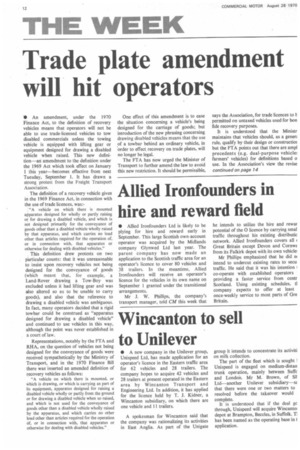Trade plate amendment will hit operators
Page 14

If you've noticed an error in this article please click here to report it so we can fix it.
10 An amendment, under the 1970 Finance Act, to the definition of recovery
vehicles means that operators will not be able to use trade-licensed vehicles to tow disabled commercials unless the towing vehicle is equipped with lifting gear or equipment designed for drawing a disabled vehicle when raised. This new defini tion—an amendment to the definition under the 1969 Act which took effect on January 1 this year—becomes effective from next Tuesday, September 1. It has drawn a strong protest from the Freight Transport Association.
The definition of a recovery vehicle given in the 1969 Finance Act, in connection with the use of trade licences, was:
:"A vehicle on which there is mounted apparatus designed for wholly or partly raising or for drawing a disabled vehicle, and which is not designed primarily for the conveyance of goods other than a disabled vehicle wholly raised by that apparatus, and which carries no load other than articles required for the operation of, or in connection with, that apparatus or otherwise for dealing with disabled vehicles."
This definition drew protests on two particular counts: that it was unreasonable to insist upon recovery vehicles not being designed for the conveyance of goods (which meant that, for example, a Land-Rover drawing a Tow-Boy was excluded unless it had lifting gear and was also altered so as to be unable to carry goods), and also that the reference to drawing a disabled vehicle was ambiguous. In fact, many operators decided that a rigid towbar could be construed as "apparatus designed for drawing a disabled vehicle" and continued to use vehicles in this way, although the point was never established in a court of law.
Representations, notably by the FTA and RHA, on the question of vehicles not being designed for the conveyance of goods were received sympathetically by the Ministry of Transport, and in the 1970 Finance Bill there was' inserted an amended definition of recovery vehicles as follows:
"A vehicle on which there is mounted, or which is drawing. or which is carrying as part of its equipment, apparatus designed for raising a disabled vehicle wholly or partly from the ground or for drawing a disabled vehicle when so raised, and which is not used for the conveyance of goods other than a disabled vehicle wholly raised by the apparatus, and which carries no other load other than articles required for the operation of, or in connection with, that apparatus or otherwise for dealing with disabled vehicles."
One effect of this amendment is to ease the situation concerning a vehicle's being designed for the carriage of goods; but introduction of the new phrasing concerning drawing disabled vehicles means that the use of a towbar behind an ordinary vehicle, in order to effect recovery on trade plates, will no longer be legal.
The FTA has now urged the Minister of Transport to further amend the law to avoid this new restriction. It should be permissible, says the Association, for trade licences to permitted on untaxed vehicles used for bon fide recovery purposes.
It is understood that the Ministr maintains that vehicles should, as a genen rule, qualify by their design or constructiat but the FTA points out that there are amp] precedents (e.g. dual-purpose vehicle: farmers' vehicles) for definitions based o use. In the Association's view the revise continued on page 14
































































































